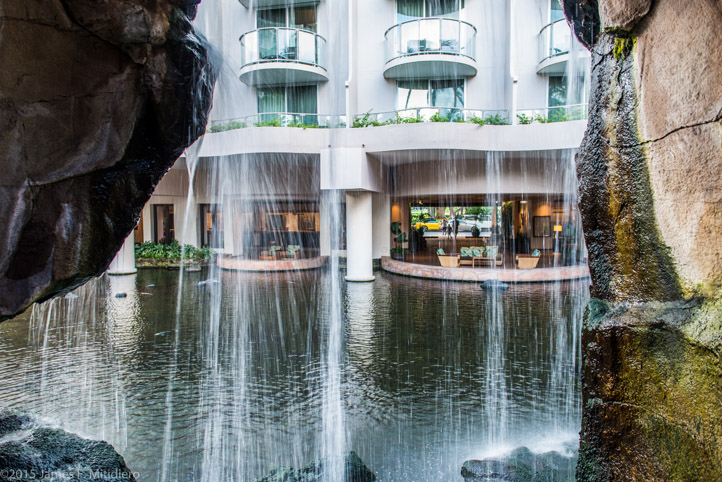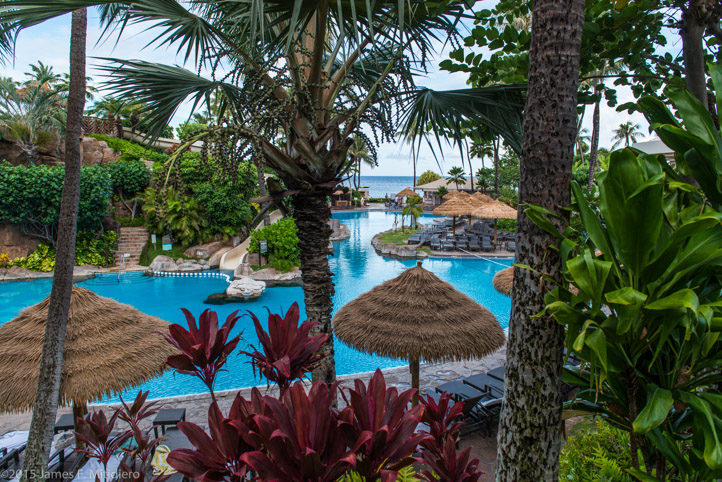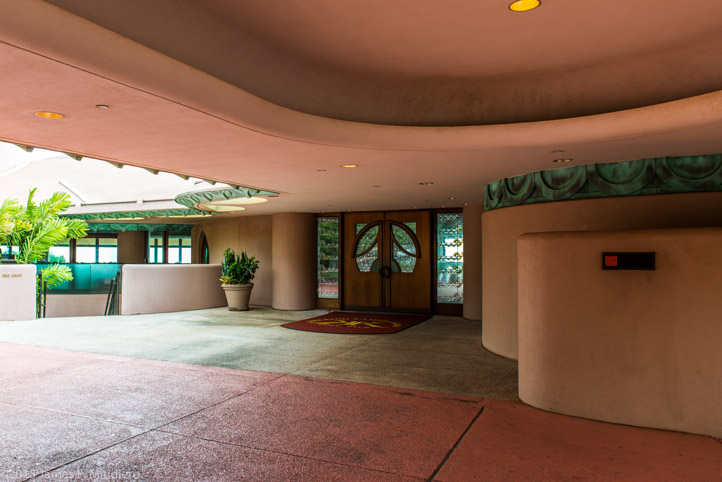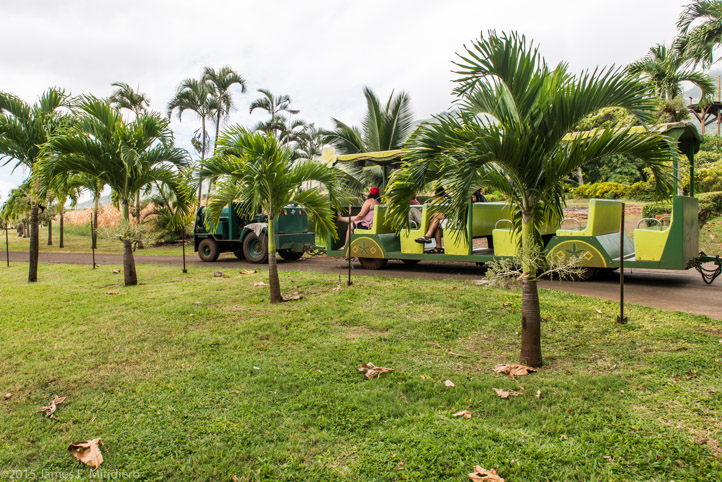Last Day
 Our last day in Maui provided a unique opportunity for photography in the four different venues we covered. We got going early in the morning before the great crowds of people descended on the Westin Hotel courtyard. Our previous pictures were from up high in our hotel room and show a nice overview of the courtyard. The pictures we snapped on our last day are all ground floor images of the courtyard and show the attention to detail given by the hotel management. The configuration of the courtyard with its small alcoves give an ambiance and feel of a much larger area. You could spend the entire day in the courtyard under a cabana or pool side just taking in the flavor. Hotel offerings are to take a dip or
Our last day in Maui provided a unique opportunity for photography in the four different venues we covered. We got going early in the morning before the great crowds of people descended on the Westin Hotel courtyard. Our previous pictures were from up high in our hotel room and show a nice overview of the courtyard. The pictures we snapped on our last day are all ground floor images of the courtyard and show the attention to detail given by the hotel management. The configuration of the courtyard with its small alcoves give an ambiance and feel of a much larger area. You could spend the entire day in the courtyard under a cabana or pool side just taking in the flavor. Hotel offerings are to take a dip or just relax in a chase lounge with a supple supply of food and drink at your beck and call.
just relax in a chase lounge with a supple supply of food and drink at your beck and call.
We were not prepared for a relaxing pool side day so we headed out north on route 30 to see the King Kamehameha Golf Club. Over the course of about a decade multiple Japanese investors invested 75 million dollars building the golf course. The first investor put in 30 million, couldn’t make any money, and filed for bankruptcy. Years later the second investor added an additional 45 million to build the golf course seen today. I am not a golfer and to appreciate the course you have to play it, although from the viewing deck, the  course is majestic and the club house is without parallel; very upscale. You get a feeling for the Hawaiian weather from some of the photographs taken from the viewing deck. It rains every day somewhere in Hawaii, mostly light and not for very long. We experienced a medium shower on the viewing deck but a small umbrella and building soffit kept us dry.
course is majestic and the club house is without parallel; very upscale. You get a feeling for the Hawaiian weather from some of the photographs taken from the viewing deck. It rains every day somewhere in Hawaii, mostly light and not for very long. We experienced a medium shower on the viewing deck but a small umbrella and building soffit kept us dry.
Our next stop was the Bailey House Museum in Wailuku, just west of the intersection of route 30 & 32, specializing in early Hawaiian history. The museum houses a significant collection of artifacts from pre U.S. statehood. Part of the collection is the Duke Paoa Kahanamoku (8/24/1890 – 1/22/68) memorial and surfboard. Duke is celebrated as Hawai’i’s greatest athlete. The memorial indicated that in 1929 Duke obtained one of the longest rides in surfing history, estimated to be at least a mile in length. The museum houses a unique Hawaiian canoe called a Honaunau; it’s an outrigger 33’ in length used for fishing the rocky shores of Kona. During the “beach boy era” of the 1930s and 1940s it was used by the Outrigger Canoe Club in their training program. No lightweight; the canoe weighs about 600 pounds.
statehood. Part of the collection is the Duke Paoa Kahanamoku (8/24/1890 – 1/22/68) memorial and surfboard. Duke is celebrated as Hawai’i’s greatest athlete. The memorial indicated that in 1929 Duke obtained one of the longest rides in surfing history, estimated to be at least a mile in length. The museum houses a unique Hawaiian canoe called a Honaunau; it’s an outrigger 33’ in length used for fishing the rocky shores of Kona. During the “beach boy era” of the 1930s and 1940s it was used by the Outrigger Canoe Club in their training program. No lightweight; the canoe weighs about 600 pounds.
 On our way back to the Westin we made our last stop of the day at the Maui Tropical Plantation. The plantation offers a trolley train, narrated trip, through the entire plantation that we found entertaining and informative. To see where bananas and avocado’s actually come from was enlightening, as I had thought they came from the local Jewel store. The climate in Hawaii is particularly conducive to agriculture as the temperature throughout the year is mostly in the 80s with low humidity and mild rain. The majority of the population reside in the major cities and coastal areas. There are vast tracts of land that is mountainous and uninhabited and an equal amount of flat land used for agriculture. We found Oahu and Maui delightful places to visit and different in topography then anyplace in the continental U.S. The culture is warm and friendly and their greeting of “Aloha” is a warm way of saying either hello or goodbye. The native Hawaiian people we saw were of solidly muscular build and eager to show their skills in music and dance. We didn’t see much industrialization in either Oahu or Maui and our Oahu photography tour guide quipped “the primary reason to live in Hawaii is for the sun and surf”. To see a slideshow of our last day click here.
On our way back to the Westin we made our last stop of the day at the Maui Tropical Plantation. The plantation offers a trolley train, narrated trip, through the entire plantation that we found entertaining and informative. To see where bananas and avocado’s actually come from was enlightening, as I had thought they came from the local Jewel store. The climate in Hawaii is particularly conducive to agriculture as the temperature throughout the year is mostly in the 80s with low humidity and mild rain. The majority of the population reside in the major cities and coastal areas. There are vast tracts of land that is mountainous and uninhabited and an equal amount of flat land used for agriculture. We found Oahu and Maui delightful places to visit and different in topography then anyplace in the continental U.S. The culture is warm and friendly and their greeting of “Aloha” is a warm way of saying either hello or goodbye. The native Hawaiian people we saw were of solidly muscular build and eager to show their skills in music and dance. We didn’t see much industrialization in either Oahu or Maui and our Oahu photography tour guide quipped “the primary reason to live in Hawaii is for the sun and surf”. To see a slideshow of our last day click here.